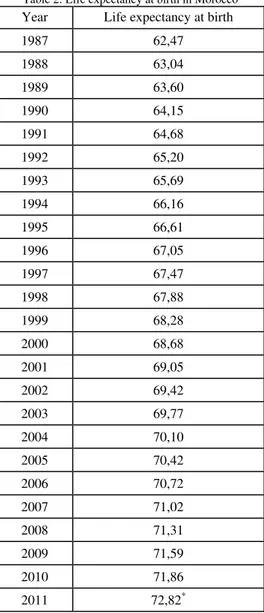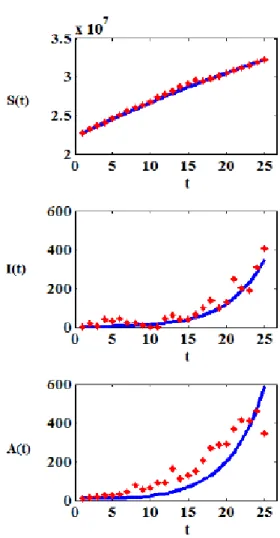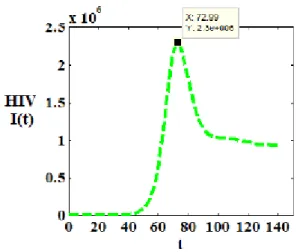Modelling the spread of HIV/AIDS in Morocco
Mohamed El hia, Omar Balatif, Hanane Ferjouchia, El houssine Labriji, Mostafa Rachik
Laboratoire d'Analyse Modélisation et Simulation, Département de Mathématiques et d'Informatique, Faculté des Sciences Ben M.Sik, Université Hassan II Mohammedia, B.P 7955, Sidi Othman, Casablanca, Maroc
Abstract
In this article, we propose a non-linear mathematical model with a variable size population to study the spread of HIV/AIDS in Morocco. We estimate the parameters that include this model based on real data. An estimation of the basic reproductive number R0 and some numerical simulations that provide insights into the future of HIV/AIDS in Morocco are also presented in this study.
Keywords: Mathematical modelling, HIV/AIDS, Parameter estimation, Basic reproductive number R0.
1. Introduction
HIV (human immunodeficiency virus) is the virus that causes AIDS (acquired immunodeficiency syndrome). By killing or damaging cells of the body's immune system, HIV progressively destroys the body's ability to fight infections and certain cancers. People diagnosed with AIDS may get life-threatening diseases called opportunistic infections, which are caused by microbes such as viruses, bacteria, fungi, or parasites. These infections do not usually make healthy people sick. Those with HIV/AIDS are also at an increased risk of developing certain cancers and a variety of other neurological disorders.
HIV/AIDS is one of the most destructive diseases humankind has ever faced, with profound social, economic and public health consequences. It has become, for three decades, a full-blown pandemic affecting all parts of the world. As reported by the latest UNAIDS report [1], the number of people living with HIV in the world in 2010 was estimated to be 34 million, including 2.7 million new infections occurred during the same year, that is 7400 cases per day. The number of AIDS deaths occurred in 2010 was about 1.8 million, according to the same source. In Morocco, the first case of AIDS was recorded in 1986. Since then, the number of new AIDS cases has continued to rise. HIV is gaining ground and according to the official data of the Ministry of Public
Health, Morocco has up to 31st December 2011, 2284 and 4169 cumulative reported cases of HIV and AIDS.
To fight HIV/AIDS, mathematical models play an important role to better understand this disease's dynamics; they provide information on the essential parameters of this dynamic, which can not be observed and predict its evolution in a given population (see for example [2-3-4-5-6]).
Following our contacts with the direction of the epidemiology and fight against diseases, within the Ministry of Public Health, we noted a lack of some national data related to the spread of HIV/AIDS in Morocco, such as the time between HIV diagnosis and the onset of AIDS, and the mean time from AIDS diagnosis to death because most of patient die outside hospitals. To overcome this problem, we propose an estimation to these parameters by fitting a mathematical model, modelling the HIV/AIDS transmission, to the statistics available in Morocco.
This paper is organized as follows: Section 2, describes a mathematical model that fits the case of HIV/AIDS. The parameter estimation and the estimated basic reproductive number R0 are presented in section 3. In section 4, we give some numerical simulations that predict the future of this epidemic in Morocco. Finally, the conclusions are summarized in section 5.
2. The model
In this section we consider a simple model, with a variable size population, where
y t = time in years
y S(t) = number of susceptible individuals;
y I(t) = number of declared HIV-positive cases without AIDS;
We suppose that the AIDS patients are removed from the population since, unlike other classes (S and I), they do not have sex anymore, and have no children. In fact, their relationships with the rest of the population are insignificant. The model is given by the following nonlinear system of differential equation:
(
)
(
)
dS I
S S
dt N
dI I
S I
dt N
dA
I A
dt
Λ μ β
β μ γ
γ μ δ
⎧ = − −
⎪ ⎪
⎪ = − +
⎨ ⎪
⎪ = − +
⎪ ⎩
(1)
where S 0( )≥0 I 0, ( )≥0 and A 0( )≥0 are given and
( ) ( ) ( ) ( )
N t =S t +I t +A t for all t. The definitions of the above model parameters are as follow
Table 1: Parameter definition
Parameter Definition Λ Recruitment rate
β Transmission coefficient μ Natural mortality rate
γ Rate of developing AIDS of
( )I individuals
δ AIDS induced mortality rate
Note that the system (1) is dissipative, that is all solutions are uniformly bounded in a proper subset Ω ⊂ +\3 where
(
S I A, ,)
3 :N t( ) ΛΩ
μ
⎧ ⎫
=⎨ ∈ + ≤ ⎬
⎩ \ ⎭
Also, the continuity of the right side of the system (1) and its derivatives implies that unique solutions exist. Therefore, the model is mathematically and epidemiologically well posed. It should also be noted that the basic reproductive number R0 of (1) is given by
R0 = μ γβ+ (2)
3. Parameter estimation
An important step for validating a given mathematical model is to estimate its parameters. In this section we give estimation for the parameters used in the model (1); the aim is to reconstruct the HIV/AIDS in Morocco in the past and simulate its future development. An estimation of the basic reproductive number R0 will also be provided in this section.
In our model we fix the natural mortality rate, μ, which is supposed to be the inverse of life expectancy at birth [7]. So, according to the database of the World Bank [8], Morocco has made, for the entire period 1987-2011 (Table 2), an average life expectancy at birth of 68 years. Hence,
0.01470588 per year
1 68
μ = =
Table 2: Life expectancy at birth in Morocco Year Life expectancy at birth
1987 62,47 1988 63,04 1989 63,60 1990 64,15 1991 64,68 1992 65,20 1993 65,69 1994 66,16 1995 66,61 1996 67,05 1997 67,47 1998 67,88 1999 68,28 2000 68,68 2001 69,05 2002 69,42 2003 69,77 2004 70,10 2005 70,42 2006 70,72 2007 71,02 2008 71,31 2009 71,59 2010 71,86
2011 72,82*
For the remaining parameters ( , , , )Λ β γ δ , they are estimated by the least squares method using data from the High Commission to the Plane [9] and the Ministry of Public Health [10] (Table 3). For the fitting procedure by the least squares method, we used the Levenberg-Marquardt method implemented in MATLAB [11] in the
*
built-in routine "lsqcurvefit" which is part of the optimization toolbox. The resulting parameter estimates are listed in Table 4, and the best model fit to the data is shown in Fig. 1.
Table 3: Statistical data for N, I and A
Year Population (N)
Susceptible (S)
VIH (I)
AIDS (A) 1987 22749000 22748989 2 9 1988 23227000 23226965 21 14 1989 23703000 23702973 7 20 1990 24177000 24176932 42 26 1991 24649000 24648938 34 28 1992 25117000 25116924 46 30 1993 25582000 25581933 23 44 1994 26073000 26072899 24 77 1995 26386000 26385933 10 57 1996 26848000 26847933 1 66 1997 27310000 27309907 1 92 1998 27775000 27774863 44 93 1999 28238000 28237774 61 165 2000 28705000 28704846 42 112 2001 29170000 29169832 39 129 2002 29631000 29630786 64 150 2003 29520000 29519696 99 205 2004 29840000 29839589 140 271 2005 30172000 30171612 100 288 2006 30509000 30508581 129 290 2007 30850000 30849386 247 367 2008 31195000 31194381 203 416 2009 31543000 31542398 190 412 2010 31894000 31893231 309 460 2011 32245000 32244247 406 347
Table 4: Parameter estimation Parameter Estimations
Λ 805479
β 0,883856382 γ 0,654004963 δ 0,163045919
Fig. 1 The best-fit solution obtained by fitting the solution of the model (1) (solid line) to the real data (dotted line) in Table 3
We find that in Morocco, the mean time between HIV diagnosis and the onset of AIDS is about one year and a half; this result can be interpreted by the fact that most diagnoses occur in more advanced stages, hence the necessity to accentuate efforts of HIV screening in Morocco. Also, the results obtained show that for the Moroccan case, the mean time from AIDS diagnosis to death is nearly six years.
Using the formula (2) and the values of the parametersβ μ, and γ , previously calculated, we obtain an estimate of the basic reproductive number R0 which is
1.32
R0 ≈
African countries that are highly affected by HIV/AIDS such as South Africa, where R0 is 7 [12].
4. Numerical simulation
In this section, we give some numerical simulations which predict the evolution of the disease in Morocco. First of all, we note that the system (1) admits an endemic equilibrium
(
)
* *, *, *
E = S I A , where
(
)
(
)
(
)
(
)
(
)
(
)
(
)
(
)
* * * * * * * 1 S N R0R0 1
I N
R0 R0 1
A N
R0
R0 N
R0 R0 1
μ δ μ δ γ
γ μ δ γ
Λ μ δ γ
μ μ δ γ δγ
= + − = + + − = + + + + = + + + −
The Jacobian matrix of the linearized system in the neighbourhood of E* is
( )
(
)
(
)
* 1 2 3
J E 1 2 3
0
μ α α α
α α μ γ α
γ μ δ
⎛− − − ⎞ ⎜ ⎟ =⎜ − − + − ⎟ ⎜ − + ⎟ ⎝ ⎠ where * * * * * * * * * * * I S 1 1 N N S I 1 2 N N S I 3 2 N α β α β α β ⎛ ⎞ ⎜ ⎟ = − ⎜ ⎟ ⎝ ⎠ ⎛ ⎞ ⎜ ⎟ = − ⎜ ⎟ ⎝ ⎠ =
Numerically, using Matlab, we find
* .
* .
* .
* .
7 S 1 3273 10
5 I 9 1263 10
6 A 3 3578 10
7 N 1 7544 10
= ×
= ×
= ×
= ×
and the eigenvalues corresponding to J E
( )
* are as follows: . . . . . 0 0561 10 0912 0 1516 i
2
0 0912 0 1516 i
3 λ λ λ = − = − + = − −
We conclude that E* is locally-asymptotically stable as the eigenvalues obtained have strictly negative real part. This result is also confirmed by Figure 2, where we observe that the population of susceptible individuals, HIV individuals and AIDS individuals converge asymptotically to the endemic equilibrium state as time increases.
Fig. 2 Evolution of the HIV/AIDS population in Morocco
Fig. 3 Evolution of the number of HIV individuals without AIDS
In Figure 4, we observe that the number of people with AIDS will continue to rise; it will reach its maximum in 2065 which is about 7.375 10× 6 cases. Then it will decrease asymptotically to the endemic equilibrium state.
Fig. 4 Evolution of the number of AIDS cases
5. Conclusion
In this paper we presented a simple model, with varying population size, describing the spread of HIV/AIDS. We then estimated the parameters of this model in order to reconstruct the epidemic in the past, to simulate its future development in Morocco, and to estimate the basic reproductive number for the Moroccan case. Although our estimates were based only on reported cases of HIV/AIDS, we note that the number of people suffering from HIV/AIDS continues to rise quickly and more intensely. Therefore, vigilance is still required and strengthening the
national strategy against HIV/AIDS is needed more than before; especially that estimates of the number of people living with HIV, published since 2003 by the Ministry of Public Health in Morocco in collaboration with UNAIDS (Fig 5), show a large discrepancy with the number of reported cases.
Fig. 5 Estimated number of people living with HIV. Morocco, 2003-2009 according to [13]
Acknowledgments
Research reported in this paper was supported by the Systems Theory Network.
References
[1] JOURNEE MONDIALE SIDA | 2011 RAPPORT ONUSIDA
[2] Knox, E. G.; A transmission model for AIDS, European J. Epidemiol. 2:165- 177 (1986).
[3] Anderson, R. M. ; Medley, G.; May, F.R. M.;and Johnson,A. M. A preliminary study of the transmission dynamics of the human immunodeficiency virus (HIV), the causative agent of AIDS, IMA J. Math. Appl. Med. Biol. 3 229- 263 (1986). [4] Dietz, K.; On the Transmission Dynamics of HIV,
Mathematical Biosciences 90:397-414 (1988). [5] Castillo-Chavez, C. and H. Thieme, Asymptotically
Autonomous Epidemic Models, In Mathematical Populations Dynamics: Analysis of Heterogeneity, Volume 1, Theory of Epidemics, O. Arino, D. Axelrod, M. Kimmel and M. Langlais(eds.), pp. 33-50.
[6] Ram Naresh _, Agraj Tripathi, Dileep Sharma, Modelling and analysis of the spread of AIDS epidemic with
immigration of HIV infectives, Mathematical and Computer Modelling 49 (2009) 880_892
[7] Anderson, R.M et May, R.M. Infectious Diseases of Humans-Dynamics and Control. Oxford University Press (1991)
[8] http://donnees.banquemondiale.org/pays/maroc#cp_wdi [9]
[10] Direction de l'épidémiologie et de lutte contre les maladies - Service des IST/SIDA -
[11] Matlab, Mathworks Inc., Natick, Mass.
[12] http://www.vih.org/20081216/modele-d-eradication-vih-pour-2016-theorie-versus-realite-1047#footnote2_5w6gore [13] Ministère de la santé publique, Mise en oeuvre de la


